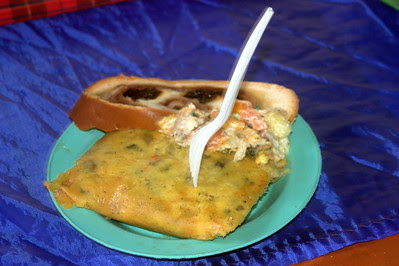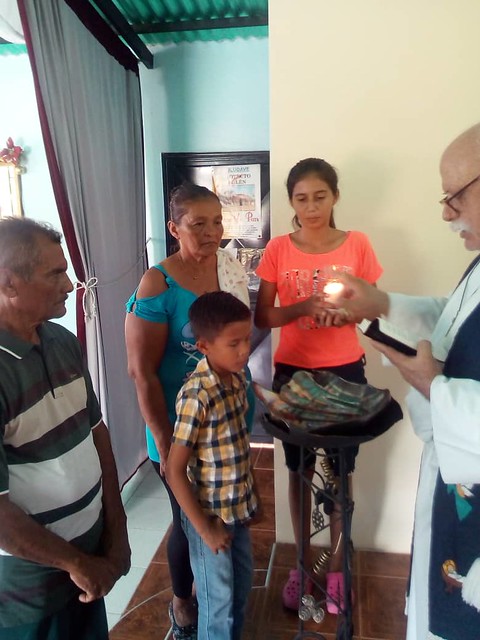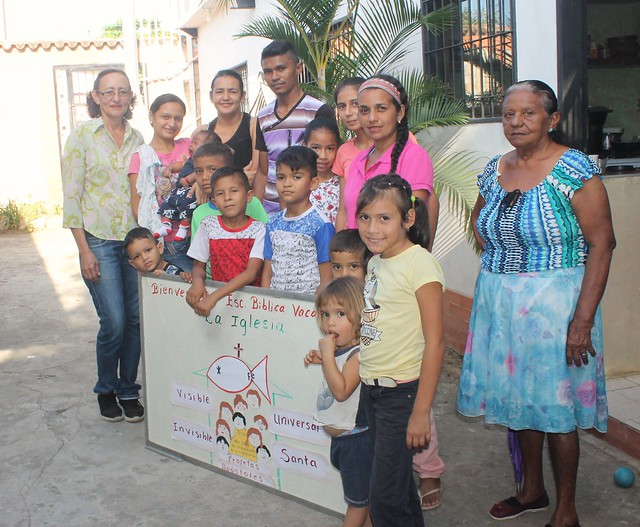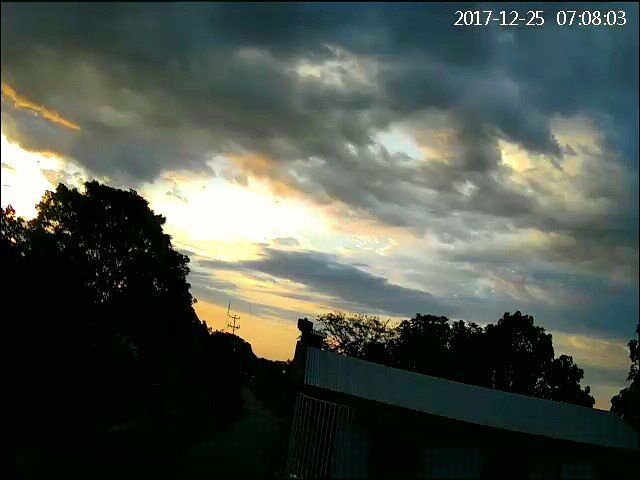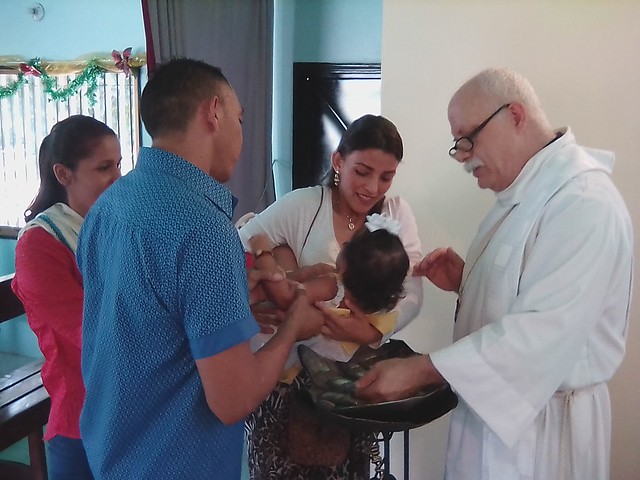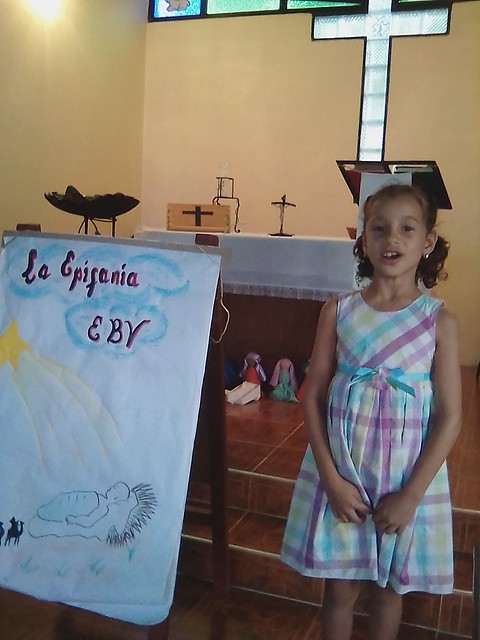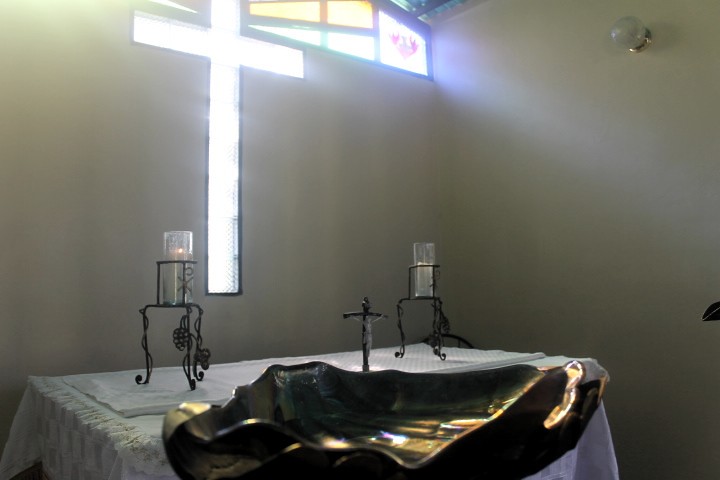The Feast of the Purification of Mary and the Presentation of Our Lord is a mouthful for a minor festival. Because of the focus on Christ as the Light of the world, this festival is often known simply as Candlemas in English-speaking countries and Candelaria in Latin America. Unfortunately, here the celebration of Candelaria often involves the unacceptable veneration of the Virgin Mary. Scripturally compatible traditions include candlelight processions and the blessing of candles to be used in the church in the upcoming year. We had already made new candles from last year’s used-up candles for distribution to children on Epiphany Sunday, so we did not do anything special with candles on February 2. However, we did follow another associated tradition of leaving up the Christmas decorations, then removing them by this date Another theme for the day is that fertility is a blessing from God and all children really belong to Him, which is emphasized in the Old Testament lesson, 1 Samuel 1:21-28. So we gave thanks for the birth of Brianna Gisell, grandchild of Mairelys Pereira, who had been one of our preschool teachers. We presented her daughter with infant clothes that had been sent to us by Yepci Santana, Luz Maria’s daughter, who is an active member of the Lutheran Church – Missouri Synod mission in Lima, Peru.
Feb 4, 2025
Celebrating light and love
The Feast of the Purification of Mary and the Presentation of Our Lord is a mouthful for a minor festival. Because of the focus on Christ as the Light of the world, this festival is often known simply as Candlemas in English-speaking countries and Candelaria in Latin America. Unfortunately, here the celebration of Candelaria often involves the unacceptable veneration of the Virgin Mary. Scripturally compatible traditions include candlelight processions and the blessing of candles to be used in the church in the upcoming year. We had already made new candles from last year’s used-up candles for distribution to children on Epiphany Sunday, so we did not do anything special with candles on February 2. However, we did follow another associated tradition of leaving up the Christmas decorations, then removing them by this date Another theme for the day is that fertility is a blessing from God and all children really belong to Him, which is emphasized in the Old Testament lesson, 1 Samuel 1:21-28. So we gave thanks for the birth of Brianna Gisell, grandchild of Mairelys Pereira, who had been one of our preschool teachers. We presented her daughter with infant clothes that had been sent to us by Yepci Santana, Luz Maria’s daughter, who is an active member of the Lutheran Church – Missouri Synod mission in Lima, Peru.
Jan 8, 2025
Shining the light of Christ
 |
| Scented gift candles made from leftover wax from altar candles. |
“For this holy house, and for all who offer here their worship and praise, let us pray to the Lord” (from the long-form Kyrie),
On Sunday, January 5, 2025, we celebrated the Epiphany of our Lord and the eighth anniversary of the consecration of our sanctuary. We began construction of a two-story church and school building a year earlier, thanks to a donation from Venezuela Lutheran Mission Partnership (VLMP).It was kairos, the right time. Four years of hyperinflation would follow, emigration from Venezuela would become a stampede, and that was before COVID-19. We would not have been able to build this holy house at any point afterward.As in past years, members of our sister congregation, Corpus Christi Lutheran Church in Barinas, worshipped with us and later joined us for a meal and cake.
Luz para las naciones
The children who attended our vacation Bible school sang “Brilla, Jesús”, a Spanish version of “Shine, Jesus, shine” in sign language, their project for the week. The simple praise song, written by Graham Kendrick in 1987, is a favorite in Venezuela. It is based on Genesis 1:3; Psalm 139:23; John 1:5; John 8:12; John 8:32; 2 Corinthians 3:18; and Revelation 22:1-2.
This fit with the theme of our vacation Bible school, “Light for the nations”. This phrase appears in the messianic prophecies of Isaiah 42:6 and Isaiah 49.6. The Hebrew word translated as “nations” refers to those outside the covenant people of Israel, and thus could also be translated as “gentiles”. A form of the phrase is used with the corresponding Greek word in Luke 2:32, as part of the Nunc Dimittis or “Song of Simeon”, that we sing after the Eucharist every Sunday: “A light for revelation to the Gentiles, and for glory to your people Israel.” In Acts 13:47, Paul and Barnabas justify preaching the Gospel to gentiles with a more direct citation of Isaiah 49:6. “For so the Lord has commanded us: “I have made you a light for the Gentiles, that you may bring salvation to the ends of the earth.”The first day of vacation Bible school was Thursday, January 2, the day after the Circumcision and Naming of Jesus on the church calendar (because it’s eight days after Christmas). So the activity involved identifying the names (or titles) given to Jesus in the Bible and choosing a favorite. Most chose “King of Kings”, but some chose “Light of the World”, “Messiah”, “Good Shepherd” and “Emmanuel”.On the second day of vacation Bible school, we compared the verses John 8:12 and Matthew 5:14-16. If Jesus said, “I am the Light of the world”, how could He also say, “You are the light of the world”? Because we are sent out into the world to shine the light of Christ into its darkness. The second part of John 8:12 reads, “He who follows me shall not walk in darkness, but have the light of life.” Our Lord also says in Matthew 5:14-16: “Let your light so shine before men that they may see you good works and glorify you Father in heaven.” So we studied the 10 Commandments and what the Small Catechism says about the third use of the law as a guide for living the Christian life.
Keeping the Mass in Christmas
On Sunday, December 29, 2024, we celebrated the Mass of the Nativity in the morning in La Caramuca and in the afternoon at Corpus Christi Lutheran Church in Barinas. This was the eucharistic service. On December 24, we marked Christmas Eve with a vespers service in La Caramuca. At both locations, worship was followed by a traditional Venezuelan Christmas dinner of hallacas, chicken salad and pan de jamón (ham-filled bread).
Creating hallacas involves wrapping a mixture of seasoned beef/pork, capers, raisins, olives, onions, garlic, peppers, and spices in masa, a corn dough. Banana leaves are used to cover the filled parcel before it’s secured with twine or string. To a gringo, the hallaca may look like a tamale, but do not call it that. With the tamale, a dish typically associated with Mexico and Central America, masa dough is filled with meats, cheese and veggies, wrapped up in corn husks and steamed. The corn husks impart a different texture and flavor.Witnesses till the end
On St. John’s Day, December 27, 2024, we met with local coordinators of other LeadaChild projects in Venezuela in a Zoom conference. We thanked everyone for their work over the past year, including Elsy Machado, national director of LeadaChild Venezuela; Nury de Milian, director of LeadaChile Latin America; and Dr. Philip Frusti, executive director of LeadaChild in the United States.
We meditated on the fact that “martyr” means “witness” in Greek. From St. Stephen (Acts 7) to the present day, many Christians have died for faith in Jesus Christ. We give thanks for their testimony, which has been the seed of the church. Even those who die for Christ without giving voice, like the Holy Innocents of Bethlehem (Matthew 2:13-23), show by their death the depth of evil and the truth of God’s Word. We also gave thanks for St. John the Evangelist, the only one among the apostles to die of old age (John 21:21-24). Some face a violent death with the help of the Holy Spirit and by their example bear witness to the truth of God’s Word. But others, like John, are blessed with a long life to teach new Christians. Those of us involved with LeadaChild are committed to seeing children grow in faith and to teaching that faith to their children.
Jan 31, 2024
He pitches His tent among us
 |
| Vacation Bible school. |
On January 22, we celebrated the Transfiguration of our Lord, witnessed by the apostles Peter, James and John (Matthew 17:1-9; Mark 9:2-13; Lucas 9:28-26). This last manifestation of the divine nature in Christ before His suffering, death and resurrection concludes the Christmas/Epiphany season.
 |
| The Tabernacle. |
 |
| Ark of the Covenant. |
 |
| The menorah. |
 |
| Solomon's Temple. |
 |
| Epiphany Sunday. |
Seventh anniversary of our temple
 |
| Alfredo and Gladys Rivas. |
Septuagesima or Carnival?
 |
| Carnaval princess. |
However, in medieval times, Lenten fasting was required, and the rules were very strict. So, as something of a practical matter, people got into the habit of conspicuous consumption during the pre-Lenten period: Throwing big parties to use up those foods which could not be eaten during Lent, and which could not even be kept in homes during the fast – meat, butter, cheese, milk, eggs, fats, and bacon – as well as other rich foods and pastries. Later on, the revelry came to include parades and masquerade balls. This came to be known as Carnival (or Carnaval in Spanish) from the Latin “Carnem levare” which means withdrawal or removal of meat. The tradition continues in Latin American countries, although in Venezuela, the celebration of Carnaval is officially limited to the Monday and Tuesday before Ash Wednesday (which, as it happens, falls on February 14, Valentine’s Day, this year).
We will hold a masquerade party for our preschool children as we have every year, but we will also use the selected readings for the pre-Lenten Sundays to emphasize the three solas of the Reformation. The readings for Septuagesima Sunday teach salvation through grace alone (Exodus 17:1-7; 1 Corinthians 9:24-10:5; Matthew 20:1-16); for Sexagesima, sola Scriptura (Isaiah 55:10-13; Hebrews 4:9-14; Luke 8:4-15); and for Quinquagesima, faith alone (1 Samuel 16:1-13; 1 Corinthians 13:1-13; Luke 8:31-43).
 |
| Our 2023 Carnaval parade float. |
Jan 11, 2021
We give Thee but thine own, whate'er the gift
In Matthew’s account of the Epiphany, when the Magi came to the house where Joseph, Mary and Jesus were living in Bethlehem, they saw the young child with Mary, and fell down, and worshipped him. Then they presented Him with precious gifts; gold, and frankincense, and myrrh. All of these were gifts fit for a king; but all were used in religious ceremonies of the time as well.
Worship and the giving of gifts to the Lord always have gone hand in hand. The first recorded sacrifice of thanksgiving is found in Genesis 4: 3-4. It appears that both Cain and Abel freely gave the firstfruits of their fields and flocks to God in response to God's blessing. Abel's offering was acceptable in God's eyes, while Cain's offering was not, because the Lord judges the hearts of men. Abel gave an offering in sincere gratitude as Cain sought to gain more of God's favor.
The next mention we have in the Bible regarding the sacrifice is in Genesis 8:20 when Noah exits the ark. Here is the first mention of the construction of an altar and burnt offerings. We do not find any written command from God. This was Noah's grateful response to God's mercy. Abraham built altars and called on the name of Jehovah (Genesis 12: 7-8). We have no idea what kind of sacrifice was offered on these altars, but we do know that they came from a thankful heart (responding to God's grace and promises).
It was not until the covenant made with the Israelites on Mount Sinai that God actually gave the command to build altars and offer sacrifices (Exodus 20:24). God gave Moses plans to support the priesthood of Aaron and his children (Exodus 29: 26-34), and the work of the Levites in the tabernacle, later the Temple of Jerusalem (Exodus 30: 11-16).
In Genesis 14:20 that we find the first mention of the word "tithe" in Scripture. Once again, we do not find any command from God. The tithe was given to Melchizedek, King of Salem, who blessed Abraham after Abraham had won a great victory over the surrounding enemies. In response to this, Abram gave him one-tenth of all spoils of war (Genesis 14: 18-20). In the book of Leviticus 27:30 there is the first mention of the tithe as "belonging to the Lord." The principle was clear: one-tenth of the crops belonged to the Lord, as well as one-tenth of the cattle, sheep, and goats. Moses laid out God's expectations and promises even more in detail in Numbers 15-19; 28-36; Deuteronomy 1-30). In addition to the annual tithe, there were second and third tithes, every two or three years, that included provisions for the poor. In addition to tithes, there were special offerings and a "temple tax."
Today our worship does not require sacrifices of animals to appease God’s righteous anger over our sin. Jesus made that perfect sacrifice once for all on the cross to restore peace between God and human beings. Nor are we required to tithe, as were Old Testament believers. Tithing is not a requirement of the 10 Commandments, which are God's universal moral law that still guides us today. Rather, it is part of the ceremonial law of the Old Testament, which separated the people of Israel from other nations, taught them about the holiness and justice of God, and pointed the way to the coming of Jesus Christ. As with animal sacrifices, circumcision, and special dietary practices, tithing is not required of those baptized in the new covenant in the blood of Christ.
As we read in the book of Acts, some of the early believers sold everything they had and gave it to the church, but not as a way to justify themselves before God. Ananias and Sapphira were not condemned because they did not tithe, nor because they did not give a certain amount, but because they lied and therefore were not faithful to God (Acts 5: 1-9). As we read in the Epistles, caring for the widows, orphans, and the less fortunate. Loving and caring for others it is a manifestation of the love with which God first loved us in Christ. The quantity of the offering is not what matters to God. In Luke 21:1-4 and Mark 12:41-44, Jesus observes that the offering of a poor widow meant much more than the larger sums of money that the rich men gave of their abundance.
Now, as God's redeemed people and a royal priesthood, we are privileged to bring our offerings, as well as praise and prayers, before God's altar. The offering, or sacrifice of thanksgiving, is a confession and recognition that everything we possess and all the good things in life belong to God, and that He alone is the source of all blessings.
In 1 Corinthians 16: 1-2, Saint Paul speaks of an offering that he is gathering from the churches in Galatia and Macedonia for the believers in Jerusalem who suffered from hunger. Several points can be learned from this verse. First, our offering should be regular, "the first day of the week." The first day of the week is Sunday when the first Christians worshiped. For the sake of order and proper worship, St. Paul suggests that Christians put their donations on a regular basis by giving at every Sunday service they attend. We have here the first mention of Sunday as an appropriate day for public worship, although it is not the exclusive day for church services, and it is not reserved by divine mandate.
As early as the fourth century A.D., the time of St. Augustine, it was customary for believers to place their offerings on the altar before receiving the Lord’s Supper. The Lutheran liturgy in its current form reflects this ancient practice. The offertory combines the offering with songs of praise and prayers of intercession in anticipation of partaking of the Lord’s body and blood. The offering isn’t a break in the Divine Service, but an act of worship.
Now, as the story of the poor widow shows, coins of gold, silver and copper were presented as offerings in ancient times. In modern times, metal currency was largely replaced by paper, either government-issued bills or checks. In our congregational life, cash or checks are what we have come to expect in the collection plate. That was true where I grew up, and, until recently, in Venezuela, too.
Cell phones and empty wallets
In the science-fiction magazines that I loved to read as a boy, there was the expectation that by the 21st Century electronic transfer of computerized “credits” would supercede paper money. I was thrilled, because, of course, I was sure I would live to see this future world, which also would include flying cars and vacations on the moon and Mars. I am as old as my grandfather was then, and the future is not what it used to be.
Venezuela is close to being a cashless society, in part due to technological advances, but also because of the hyperinflation that has made Venezuelan currency completely worthless. Almost all financial transactions are done via debit/credit card or cellphone, which nearly everyone has. Even street vendors have wireless point-of-sale devices, and no one writes checks because electronic payment with a card or cell phone is almost immediate. Any cash payments are in US dollars or Colombian pesos that have somehow filtered across the border, but still are not available from banks. In fact, all prices are posted in dollars and if you don't have dollars, you have to ask what the rate of exchange is at that moment in time to make your electronic transfer. People who do not have access to electronic account transfer or foreign currency have largely gone back to the barter system.
The problem for us is, if no one carries cash anymore, what’s left to put in the collection plate? Again, it’s not the quantity collected, it’s actually having something to place on the altar as part of our worship.
Of course, we can give people the data to make electronic deposits to the missions account and we certainly will. But what of the visible, public confession that is the offering? One alternative is having people write the amount of their electronic deposits on a piece paper and put it in an envelope for the offering. We also will renew our effort, which we started some time ago, to encourage offerings in kind. Clothes, food, household items whatever they may have to share.
To be sure, online banking enables to receive your donations and continue our service to our people in these difficult economic times. Thanks to all who contributed to Epiphany Lutheran Mission this past year!
Prophetic puppet show
We
started a vacation Bible school for the children of the Las Lomas
Sector on Epiphany, January 6, 2021. There were 38 children in attendance the first day, 36 on the second, and 38 on the third.
The theme was "The Law and the Prophets point to Christ." Moses, Elijah, and John the Baptist spoke to the children in the form of puppets. Every day of the vacation Bible school there was time for crafts, games, snacks and finally, prizes for everyone. We still use puppets made for us in 2003/2004 by Nancy Kapernick and volunteers from Woodbury Lutheran Church of Woodbury, Minnesota, and St. Michael’s Lutheran Church of Bloomington, Minnesota.
We find the story of the Epiphany, or the visit of the Magi, in Matthew 2: 1-23. Among the four gospels, the Gospel according to St. Matthew in particular emphasizes the fulfillment of the Messianic prophecies of the Old Testament in Jesus Christ.
The first people who paid homage to Jesus from outside Bethlehem were the wise men from the East. In their exile in the eastern regions of Palestine, the Jews spoke of the prophecies of the Messiah, the King of kings and Savior of the world promised in the Old Testament books from Abraham to Moses and prophets like Elijah. They had heard the prophecies as legend and guided by a star, the magi traveled to the land of the Jews.
The season of the Epiphany ends with the celebration of the Transfiguration when Moses and Elijah appeared next to Jesus. Also in the Epiphany season we celebrate the baptism of our Lord by John the Baptist, the last of the old covenant prophets with Israel.
Feb 3, 2020
Until day dawns and the morning star rises
 |
| Studying the Transfiguration. |
 |
| Baptism of Jesus. |
 |
| Studying geography. |
Jan 7, 2020
Baptisms and confirmations from Advent to Epiphany
 In the cultural
context of Venezuela, everyone is given time off for most of December
and the first week of January. In the past, most have used this free
time for vacations in the mountains or the beaches, or for visits
with family members (even if these are relatives that they see every
other day of the year anyway). Because of the current economic
cristis, much of this activity has been scaled way back. But still
too many have forgotten the real reason to celebrate in due time.
In the cultural
context of Venezuela, everyone is given time off for most of December
and the first week of January. In the past, most have used this free
time for vacations in the mountains or the beaches, or for visits
with family members (even if these are relatives that they see every
other day of the year anyway). Because of the current economic
cristis, much of this activity has been scaled way back. But still
too many have forgotten the real reason to celebrate in due time.Jan 8, 2019
One flock, one Shepherd
 In the week before
Epiphany, the mission hosted a vacation Bible school with total
attendance of 70 children over three days. “Jesus the Good
Shepherd” was the theme. The first day focused on the shepherds who
visited the Christ Child in Luke 2:8-20. The Bible story for day two
was David the shepherd boy who faced the giant, Goliath, in 1 Samuel
17. On the third day we looked at John 10 and what Jesus meant when
he said “I am the Good Shepherd; I know My sheep and My sheep know
Me.” (verse 14). Also, how the words of verse 16, “I have other
sheep that are not of this fold. I must bring them also, and they
will listen to my voice. So there will be one flock, one shepherd”
relates to the Great Commission, “Go and make disciples of all
nations, baptizing them in the name of the Father, the Son and the
Holy Spirit, and teaching them all that I have commanded you.”
(Matthew 28:19-20).
In the week before
Epiphany, the mission hosted a vacation Bible school with total
attendance of 70 children over three days. “Jesus the Good
Shepherd” was the theme. The first day focused on the shepherds who
visited the Christ Child in Luke 2:8-20. The Bible story for day two
was David the shepherd boy who faced the giant, Goliath, in 1 Samuel
17. On the third day we looked at John 10 and what Jesus meant when
he said “I am the Good Shepherd; I know My sheep and My sheep know
Me.” (verse 14). Also, how the words of verse 16, “I have other
sheep that are not of this fold. I must bring them also, and they
will listen to my voice. So there will be one flock, one shepherd”
relates to the Great Commission, “Go and make disciples of all
nations, baptizing them in the name of the Father, the Son and the
Holy Spirit, and teaching them all that I have commanded you.”
(Matthew 28:19-20). We distributed among
the families of the vacation Bible school children copies of “A
Child’s Garden of Bible Stories in Spanish”. The original
English version by Arthur W. Gross was first published in 1948. The
Spanish version was made available to us through the efforts of the
Lutheran
Heritage Foundation. Some copies received from Castillo Fuerte
Lutheran Church in Lima, Peru, during our visit there. Others were
shipped to the Lutheran Church of Venezuela and brought to us by
Roamird Castillo, Luz Maria’s nephew. The Spanish translation was
by Luz Guerrero-Pacheco, a deaconess at Woodbury Lutheran Church of
Woodbury, Minnesota. She, Luz Maria and myself served as volunteers
in Monagas state, Venezuela, in 2004. In 2006, Luz Guerrero visited
us in Barinas with a short-term mission team from Woodbury. We also
put on a puppet show for the vacation Bible school with handpuppets
given to us by Nancy Kapernick of Woodbury Lutheran Church in 2004.
We distributed among
the families of the vacation Bible school children copies of “A
Child’s Garden of Bible Stories in Spanish”. The original
English version by Arthur W. Gross was first published in 1948. The
Spanish version was made available to us through the efforts of the
Lutheran
Heritage Foundation. Some copies received from Castillo Fuerte
Lutheran Church in Lima, Peru, during our visit there. Others were
shipped to the Lutheran Church of Venezuela and brought to us by
Roamird Castillo, Luz Maria’s nephew. The Spanish translation was
by Luz Guerrero-Pacheco, a deaconess at Woodbury Lutheran Church of
Woodbury, Minnesota. She, Luz Maria and myself served as volunteers
in Monagas state, Venezuela, in 2004. In 2006, Luz Guerrero visited
us in Barinas with a short-term mission team from Woodbury. We also
put on a puppet show for the vacation Bible school with handpuppets
given to us by Nancy Kapernick of Woodbury Lutheran Church in 2004. About three weeks
have passed without power outages that lasted more than an hour (we
still may lose electricity at any time night or day, but not the
entire day). This is good, because we have to rely on our electric
stove for cooking, as there is an extreme shortage of LP gas. We have
both electric and LP stoves in our living quarters. During the
lengthy power outages, the LP gas stove held us in good stead. Now
it’s the electric range’s turn. The preschool has its own LP gas
stove, but we will have to replace it soon, because of its bad state
of repair.
About three weeks
have passed without power outages that lasted more than an hour (we
still may lose electricity at any time night or day, but not the
entire day). This is good, because we have to rely on our electric
stove for cooking, as there is an extreme shortage of LP gas. We have
both electric and LP stoves in our living quarters. During the
lengthy power outages, the LP gas stove held us in good stead. Now
it’s the electric range’s turn. The preschool has its own LP gas
stove, but we will have to replace it soon, because of its bad state
of repair.
Jan 23, 2018
The light that shines in darkness
We began 2018 with the loss of artificial light: A power outage that lasted from 4:30 to 8:30 a.m. on January 1. These outages have become a fact of life as Venezuela's economic crisis worsens. There is a spiritual darkness here much worse than when the electricity goes down before dawn. There is the loss of joy and hope as children die of starvation and diseases that once had been nearly eradicated; the mourning of old people as their children and grandchildren flee to other lands, perhaps never to return; the fear of someone trying the lock on your front door in the middle of the night.
But there is the light that no darkness can overcome, and that is the light of Christ. We began the chuch's year by lighting Advent candles and celebrated the beginning of the Christmas season with the baptism of Emily Antonella Torres on Sunday, December 24. Her mother, Deisi, was baptized at our mission in 2007, along with her sisters, Yexi and Yaneth, and brothers, Yovani and Jhonny. Yexi's daughter, Diana, was baptized on January 8, 2017, at the consecration of our chapel. Deisi and Yovani were confirmed on October 25, 2009. Yaneth was confirmed on December 15, 2015.
The following Sunday, December 31, we remembered the circumcision and naming of Jesus. On Wednesday of the following week, we began a vacation Bible school (since schools were closed and most people were on vacation until January 6). The theme of vacation Bible school was "epiphany" as the manifestation of the divinity of Jesus Christ.
On Sunday, January 7, we remembered the visit of the Magi to the baby Jesus in Bethlehem and celebrated the first anniversary of the consecration of our chapel. Our preschool resumed on January 8. In the weeks that followed, I shared with the preschool children the stories of the baptism of Jesus and 12-year-old Jesus in the Temple. We concluded the season of Epiphany with the celebration of the Transfiguration of our Lord on Sunday, January 21.
The book of Genesis says that in the beginning God created light by the power of His Word. The Apostle John says that by this Word all things were made, in fact, because the Word existed in the beginning with God, that is, with the Father and the Spirit who hovered over the face of the great deep. This Word was God, along with the Father and the Spirit, and it may be spoken of as the Son, for it it was begotten, but not made, in the mind of the Father from eternity. This same Word was made flesh in the person of Jesus of Nazareth, and He became the light and life of men through His death and resurrection. By the power of the Word that created the world, sinful humans gain new life through baptism. In this there is joy, hope and love that lasts forever, which casts out fear, sadness and despair. Amen.
Jan 5, 2017
Baptism now saves you (1 Peter 3:21)
During the season of Advent, many of our appointed texts focus on John the Baptist: How he prepared the way for the first coming of Christ, and how the baptism of John differed from the baptism of Jesus.








